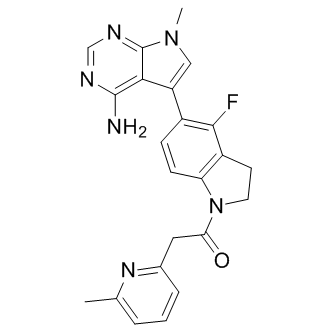The phosphorylation motif for TBK1 has not been previously reported. Here, a positional scanning peptide library technology was used to determine the optimal phosphorylation motif for TBK1. We demonstrate that the substrate specificity of TBK1 is identical to that of IKKe, but differs from the phosphorylation motif of IKKb at key positions. Importantly, we also demonstrate that, like IKKe, TBK1 phosphorylates its predicted optimal peptide more efficiently than an optimal peptide for IKKb or a peptide containing the IKKb phosphorylation sites present in IkBa. We then used this information to develop and validate an IKKe/TBK1 peptide substrate appropriate for highthroughput chemical screening and executed a high-throughput screen against both TBK and IKKe. The development of effective small-molecule screening technologies for kinases is dependent on appropriately measuring changes in enzyme activity. While phosphorylation of a known protein substrate can be measured as a reporter for kinase activity, a peptide substrate is usually superior, as it is easier to generate large, consistent quantities, and is  more amenable to the development of non-radioactive assays. However, the generation of an optimal peptide substrate requires a thorough understanding of kinase substrate specificity, and this information is only available for a small fraction of the.500 protein kinases in the human genome. The substrate specificities of three IKK family members, IKKa, IKKb and IKKe, have recently been described. Like IKKe, TBK1 is a noncanonical IKK family member which regulates Type I interferon signaling and may play a role in oncogenesis. Here, a positional scanning peptide library technology was utilized to identify the optimal phosphorylation motif for TBK1. The substrate specificity of TBK1 is identical to that of related kinase IKKe. Interestingly, the substrate specificities of the noncanonical IKKs share overlapping characteristics with the substrate specificity of the canonical IKKs, but the optimal peptide substrates for these kinases are quite different. These data allowed the generation of a peptide substrate for TBK1 and IKKe which is amenable to high-throughput screening. This technology was then used to screen the LOPAC library and a kinase-focused library to discover in vitro inhibitors of TBK1 and IKKe. This HTS revealed that 227 compounds in this library inhibited TBK1 at a concentration of 10 mM and 57 compounds inhibited IKKe, including several compounds that inhibited these enzymes at sub-micromolar concentrations. Of the compounds tested in this screen, the molecules in the LOPAC library were of MDV3100 particular interest since this library contains known bioactive molecules. The best TBK1/IKKe inhibitors from the LOPAC library are therefore shown in Table S1. Unfortuntately, none of the compounds from the LOPAC library were among the best inhibitors of IKKe or TBK1, and many lacked specificity as they also inhibited IKKa. Studies examining the ability of the compounds in Figure 7 to inhibit TBK1 or IKKe in cell-based assays are ongoing. As TBK1 and IKKe are points of convergence for both inflammatory and oncogenic signaling pathways, the further refinement of novel TBK1/IKKe inhibitors may provide NVP-BKM120 cost powerful new therapeutic drugs for inflammatory disorders or cancer. The lipid droplet is a subcellular structure that exists in a range of organisms from archaea to mammals. The LD used to be regarded as an inert lipid depot, but recent studies have revealed that it is an active organelle engaged in a wide range of activities. The main function of LDs is to store lipids and to supply them for various cellular needs, such as b-oxidation, membrane biogenesis, and lipoprotein synthesis.
more amenable to the development of non-radioactive assays. However, the generation of an optimal peptide substrate requires a thorough understanding of kinase substrate specificity, and this information is only available for a small fraction of the.500 protein kinases in the human genome. The substrate specificities of three IKK family members, IKKa, IKKb and IKKe, have recently been described. Like IKKe, TBK1 is a noncanonical IKK family member which regulates Type I interferon signaling and may play a role in oncogenesis. Here, a positional scanning peptide library technology was utilized to identify the optimal phosphorylation motif for TBK1. The substrate specificity of TBK1 is identical to that of related kinase IKKe. Interestingly, the substrate specificities of the noncanonical IKKs share overlapping characteristics with the substrate specificity of the canonical IKKs, but the optimal peptide substrates for these kinases are quite different. These data allowed the generation of a peptide substrate for TBK1 and IKKe which is amenable to high-throughput screening. This technology was then used to screen the LOPAC library and a kinase-focused library to discover in vitro inhibitors of TBK1 and IKKe. This HTS revealed that 227 compounds in this library inhibited TBK1 at a concentration of 10 mM and 57 compounds inhibited IKKe, including several compounds that inhibited these enzymes at sub-micromolar concentrations. Of the compounds tested in this screen, the molecules in the LOPAC library were of MDV3100 particular interest since this library contains known bioactive molecules. The best TBK1/IKKe inhibitors from the LOPAC library are therefore shown in Table S1. Unfortuntately, none of the compounds from the LOPAC library were among the best inhibitors of IKKe or TBK1, and many lacked specificity as they also inhibited IKKa. Studies examining the ability of the compounds in Figure 7 to inhibit TBK1 or IKKe in cell-based assays are ongoing. As TBK1 and IKKe are points of convergence for both inflammatory and oncogenic signaling pathways, the further refinement of novel TBK1/IKKe inhibitors may provide NVP-BKM120 cost powerful new therapeutic drugs for inflammatory disorders or cancer. The lipid droplet is a subcellular structure that exists in a range of organisms from archaea to mammals. The LD used to be regarded as an inert lipid depot, but recent studies have revealed that it is an active organelle engaged in a wide range of activities. The main function of LDs is to store lipids and to supply them for various cellular needs, such as b-oxidation, membrane biogenesis, and lipoprotein synthesis.